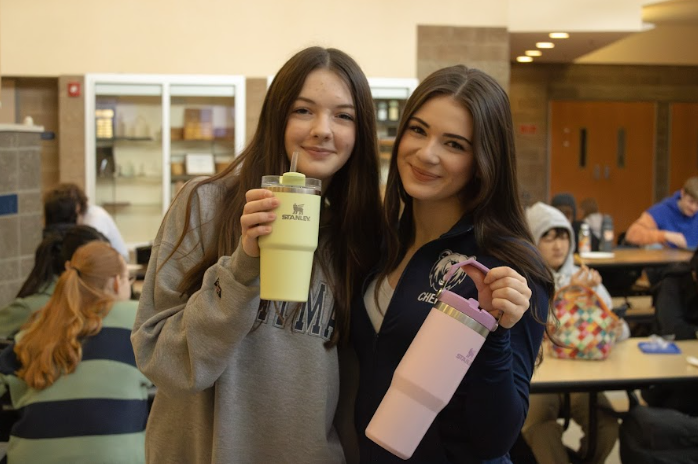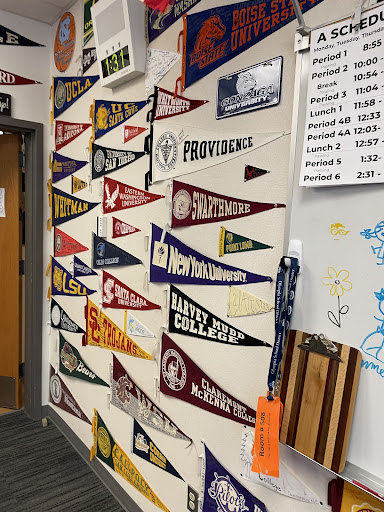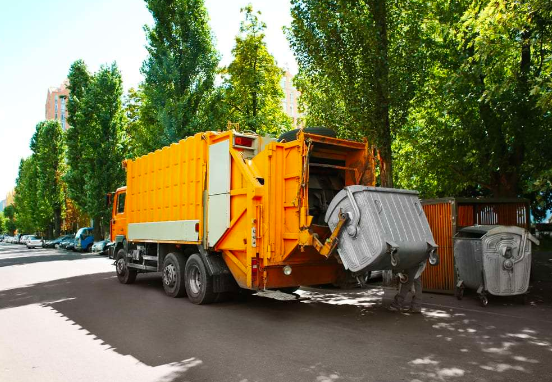It’s a symbol of middle school social status, boasts a TikTok hashtag with more than 7.6 billion views total, and shared the stage with Dakota Johnson in a recent “Saturday Night Live” skit. Its price ranges anywhere from $35 to $400, and $2,500 worth of it was stolen from a store in California.
What is “it?” The Stanley Quencher, superstar of the latest social-media, consumerism-induced water bottle trend.
One quick scan across the lunchroom and it’s obvious: OHS students are no strangers to the Stanley craze. The cups are seemingly everywhere, often with entire friend groups owning Stanleys in different colors and designs.
But the Stanley obsession runs far beneath the surface of mere hydration and pastel popularity.
For those struggling with not drinking enough water, the Stanley, in all its aesthetic, straw-filled glory, has been a positive influence. Sophomore Jahnavi Baldini exemplified: “If I have something pretty to drink water out of, it encourages me to drink more.”
Anika Prabakar, another sophomore who received her Stanley as a birthday gift from her friend, loves it because if she’s “dehydrated and not drinking water, [her] ice stays cold for three days.”
Even Career and Technical Education teachers like Kelly Boyer, who owned a Stanley before it became a nationwide trend, attest to the cup’s appeal.
“From a 45-year-old perspective, the best thing about these Stanleys is they’re 40 ounces, so you have a decent amount of water that doesn’t get warm throughout the day, but it also fits in your car’s cup holder.”
It may seem like the Stanley rage is fueled primarily by girls at first glance, but the cup has found its way into the hearts of guys too.
Senior Zach Song is one of them. “I love Stanleys because they motivate you to drink water because of the straw. And you can fit a Venti Starbucks cup in them, which keeps your Starbucks drink cold,” he enthusiastically explained.
With photo and video proof circulating online, The Stanley cup also has its downsides: leakage (which can be mediated with “spill stoppers”), mold, and even possible lead poisoning.
Senior Margot Chartock doesn’t understand why they’re a trend. “I just don’t get why they’re so tall. And they look like they’re going to fall over,” she remarked.
Recalling Hydro Flasks from the “VSCO Girl” trend from a few years ago, Football Coach Nick Mullen views Stanley cups as “just another fad, just another Hydro Flask.”
Sophomore Edmar Hernandez, who uses a Gatorade Squeeze bottle, is slightly more anti-Stanley. “Stanleys suck!” exclaimed Hernandez as he criticized the cup for being “overrated.”
A selling point of the Stanley is its durability–one woman’s drink stayed cold even after her car caught on fire and Stanley even paid for her new car (genius move)–and its sustainability.
But how sustainable is a water bottle if people are buying 67 of them (equivalent to $3,000) so they can have a Stanley to match every outfit?
Junior Grace Borden and Senior Samantha Cornfeld both point out the irony between the Stanley cup trend and the point of a reusable cup.
Borden reasoned that if someone has one water bottle and they bring it to school, that’s okay because it’s “reusable, high-quality, will never be destroyed, so [people] can get one and use that one forever.”
However, her issue lies with people “collecting” water bottles and not actively using them.
Cornfeld shared a similar sentiment: “When you buy multiple of the same water bottle, especially when it’s just to have something trendy, the overconsumption neglects any impact a reusable water bottle would have.”
Borden continued by critiquing consumerist culture for its chokehold on young girls. “These people who aren’t even in high school going feral for a new-colored Stanley at Target is actually crazy,” not to mention longtime employees getting fired for “violating company policies” by buying limited-edition Stanleys…
Social media is more than partially responsible for the widespread Stanely phenomenon. Boyer was introduced to her beloved Stanley through an Instagram influencer.
Boyer clarified that initially, customers had to order Stanleys right as they came out. So, she began receiving texts and notifications when the next drop of available colors was coming.
“If it wasn’t for social media and that Instagram account, I never would’ve known about the Stanley cup until now,” Boyer emphasized.
Borden has also experienced the dominance of the Stanley cup online: “Some of the videos I see on [Instagram] Reels and short-form content is crazy! I’m baffled by how insane people get about the most trivial things and how important they make these passing fits of fashion.”
What’s next? Consumerism (and students) predict the Owala FreeSip Water Bottle.
Phoebe Goh, who has owned her Owala for over a year, prefers its color and design. “Although it’s not spillproof all the time, I like the hidden straw and it can fit in my backpack,” she revealed.
Baldini and Prabakar also see the Owala coming into fashion soon. “They’re kind of compact, and I really like how you can sip it. I also think the colors are cute,” Prabakar described.
On the other hand, Hernandez doesn’t think there should even be a next water bottle trend. He wisely shared: “It’s just a water bottle. You drink out of it.”
After warning against “microtrends like supernovas that die in two minutes,” Borden predicted that Stanley cups will go out of fashion soon. “Then it’s not going to matter what kind of water bottle you have,” she remarked.
Thankfully, cheaper, more accessible alternatives to the Stanley exist. And this isn’t a reference to Fisher-Price’s new Stanley-coded cup (that doesn’t even hold liquid) for infants.
Owala is a viable option and sells a tumbler reminiscent of the Stanley Quencher. So does Hydro Flask. For those on a budget, online stores like Amazon, AliExpress, and Temu have Stanley-esque bottles for less than $15.
Hernandez suggested people invest in a Yeti that will “last you eight years if you want.” Borden thinks everyone should “get a nice water bottle in a color [they] like, put stickers on it, and be done.”
Both have valid points, but only time will tell if society will ever stop spending on trendy water bottles and start sipping on what’s important.









